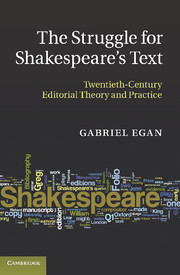Book contents
- Frontmatter
- Contents
- Preface
- Acknowledgements
- A note on references, quotations, names and pronouns
- Introduction
- 1 The fall of pessimism and the rise of New Bibliography, 1902–1942
- 2 New techniques and the Virginian School: New Bibliography 1939–1968
- 3 New Bibliography 1969–1979
- Intermezzo: the rise and fall of the theory of memorial reconstruction
- 4 New Bibliography critiqued and revised, 1980–1990
- 5 The ‘new’ New Bibliography: the Oxford Complete Works, 1978–1989
- 6 Materialism, unediting and version-editing, 1990–1999
- Conclusion: the twenty-first century
- Appendix 1 How early modern books were made: a brief guide
- Appendix 2 Table of Shakespeare editions up to 1623
- Appendix 3 Editorial principles of the major twentieth-century Shakespeare editions
- Works cited
- Index
4 - New Bibliography critiqued and revised, 1980–1990
Published online by Cambridge University Press: 06 December 2010
- Frontmatter
- Contents
- Preface
- Acknowledgements
- A note on references, quotations, names and pronouns
- Introduction
- 1 The fall of pessimism and the rise of New Bibliography, 1902–1942
- 2 New techniques and the Virginian School: New Bibliography 1939–1968
- 3 New Bibliography 1969–1979
- Intermezzo: the rise and fall of the theory of memorial reconstruction
- 4 New Bibliography critiqued and revised, 1980–1990
- 5 The ‘new’ New Bibliography: the Oxford Complete Works, 1978–1989
- 6 Materialism, unediting and version-editing, 1990–1999
- Conclusion: the twenty-first century
- Appendix 1 How early modern books were made: a brief guide
- Appendix 2 Table of Shakespeare editions up to 1623
- Appendix 3 Editorial principles of the major twentieth-century Shakespeare editions
- Works cited
- Index
Summary
… it is not inconceivable that in the future we can make better texts of Shakespeare than we have today. I do not see any drastic or sensational changes. As long as the current consensus of opinion about the authority of the texts is substantially correct, as I believe it is, there is no possibility of a drastic shake-up; that would follow only the upsetting of our notions of authority.
(Shaaber 1947, 108)PRECURSORS OF NEW TEXTUALISM
In 1935, C. S. Lewis initiated an exchange of letters in the Times Literary Supplement by suggesting that Shakespeare's primary artistic intention was to create performances rather than write a definitive manuscript, and so modern editors seeking to recover from the early editions the words of the lost definitive authorial manuscript were chasing something that never existed (Lewis 1935a; Bateson 1935; Wilson 1935a; Lewis 1935b; Lawrence 1935a; Wilson 1935b; Ridley 1935; Greg 1935; Lawrence 1935b; Wilson 1935c). Any manuscript Shakespeare created would at best be only the ‘embryo’ of his final object, Lewis argued, requiring others to work upon it and merge their creativity with his in order to produce Shakespeare's intended outcome, the performance. In his contribution W. J. Lawrence cited similar objections to editorial method made in 1917 and 1928. W. W. Greg agreed with Lewis that scripts are not fixed but change over time as they are reworked by their authors, by scribes and (in the case of plays) by theatre practitioners.
- Type
- Chapter
- Information
- The Struggle for Shakespeare's TextTwentieth-Century Editorial Theory and Practice, pp. 129 - 166Publisher: Cambridge University PressPrint publication year: 2010



